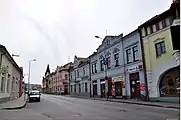Žitný ostrov
Žitný ostrov (Rye Island), also called Veľký Žitný ostrov (Great Rye Island), (German: Große Schüttinsel or Great Schütt Island, Hungarian: Csallóköz) to differentiate it from Malý Žitný ostrov (Small Rye Island) (German: Kleine Schüttinsel or Little Schütt Island, Hungarian: Szigetköz), is a river island in southwestern Slovakia, extending from Bratislava to Komárno. It lies between the Danube, its tributary Little Danube and Váh. The island is a major part of the Danubian Flat. It is the biggest river island in Europe, with an area of 1,886 km2 (728 sq mi), measuring 84 km (52 mi) in length and 15 to 30 km (9.3 to 18.6 mi) in width.

The main towns on the island are Komárno (Révkomárom), Dunajská Streda (Dunaszerdahely) and Šamorín (Somorja). Boroughs of Bratislava, Vrakuňa and Podunajské Biskupice are also located on the island. The Slovnaft refinery is also located on the island. The island is the biggest drinking water reservoir in Slovakia, and one of the biggest in Europe, as well. Because of its warm climate, good soils and water reservoirs it is an important agricultural region, with the best conditions for crop production.[1] It is the most fertile region in Slovakia, causing the majority of the island to be deforested.
Southern parts of Žitný ostrov by the Danube are protected by Dunajské luhy Protected Landscape Area.
Etymology
Current slovak name of the island is modern and it's derived from the phonetic similarity of German Schütt (meaning dike) and Slovak žito (rye). This name was accepted and is commonly used also because of the fact, that the island is very fertile region used for crop production.
The original name of the island is of Hungarian origin (1250 Chollocuz).[2] Stanislav incorrectly reconstructed the name as *Čalov (like Czech Čálovice, Serbian Čalovići or Polish Nieczałów, Varsik as *Čelov (like Čelovce in Eastern Slovakia).[3] The Hungarian name Csallóköz is derived from the old Hungarian name of the Little Danube - Csalló.
.jpg.webp) Litlle Danube, which forms Žitný Ostrov, along with the Danube and Váh rivers
Litlle Danube, which forms Žitný Ostrov, along with the Danube and Váh rivers Slovnaft raffinery in Bratislava
Slovnaft raffinery in Bratislava Dunajská Streda, one of towns located on Žitný ostrov
Dunajská Streda, one of towns located on Žitný ostrov Komárno, one of towns located on Žitný ostrov
Komárno, one of towns located on Žitný ostrov
References
- http://www.televize.cz/clanky/dilo-dunaje-nejvetsi-ricni-ostrov-evropy-3420 (in Czech)
- https://www.sulinet.hu/oroksegtar/data/kulhoni_magyarsag/2009/A_csallokoz_sziveben/pages/013_csallokoz_nev_nyomaban.htm
- Hladký, Juraj (2013). "Vlastné meno onymickom v regionálnom systéme" (PDF). Актуальні проблеми філології та перекладознавства (in Slovak): 298. ISSN 2415-7929.
External links
- Žitný ostrov at Slovakia.travel
- . Collier's New Encyclopedia. 1921.
- . New International Encyclopedia. 1905.
